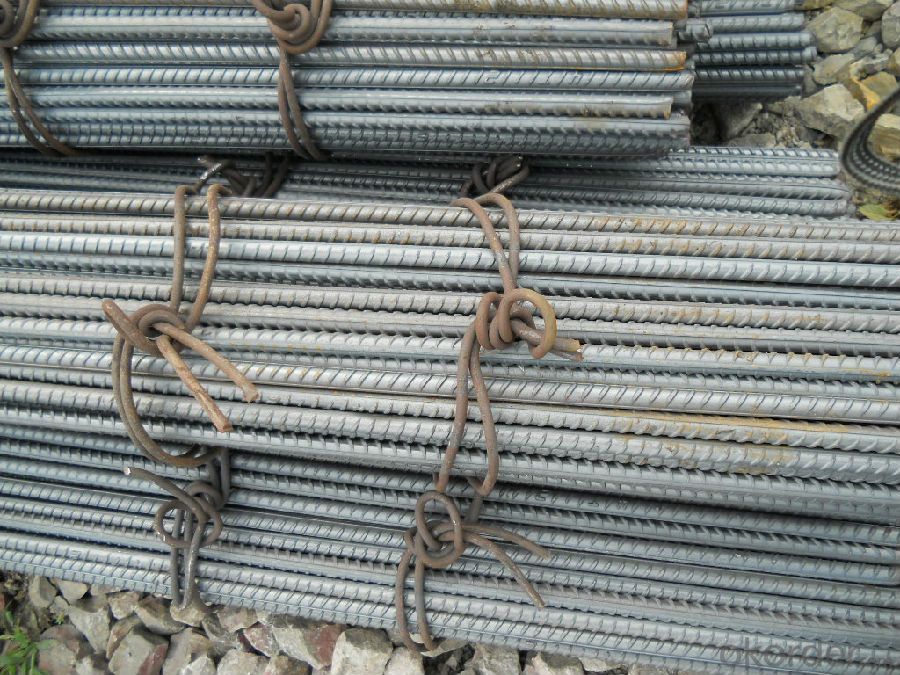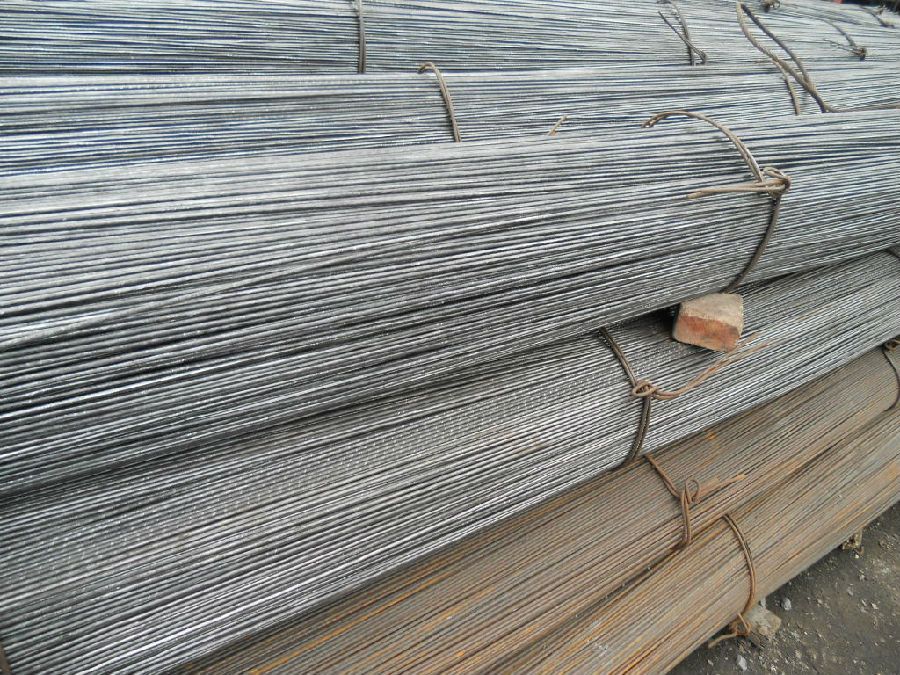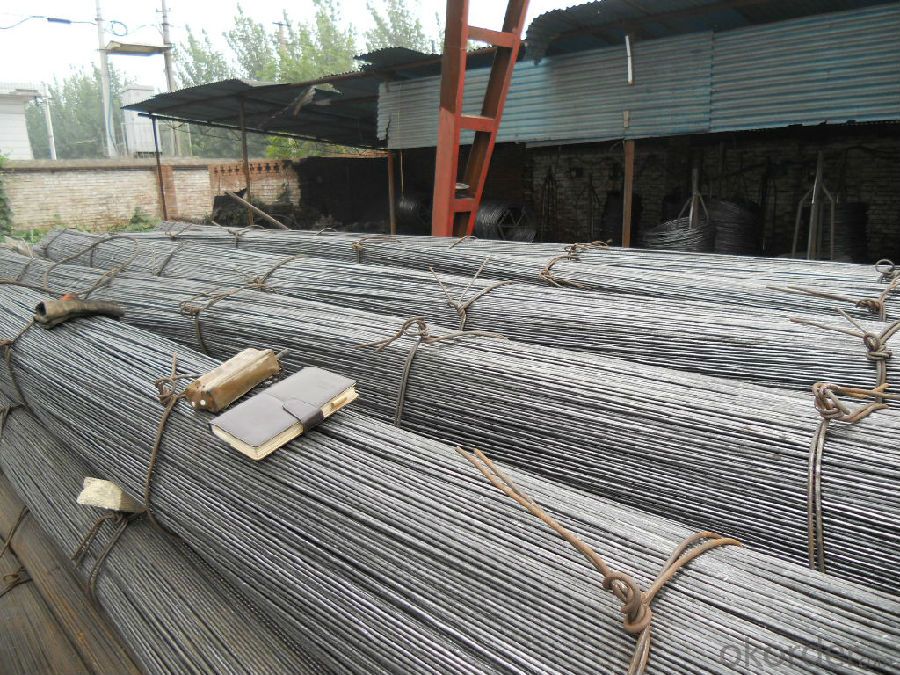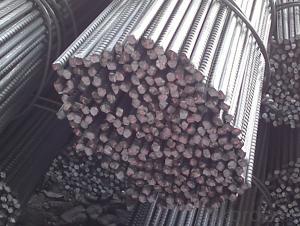A615 deformed steel bars for construction
- Loading Port:
- Tianjin
- Payment Terms:
- TT or LC
- Min Order Qty:
- 25 m.t.
- Supply Capability:
- 100000 m.t./month
OKorder Service Pledge
OKorder Financial Service
You Might Also Like
Product Description:
OKorder is offering A615 deformed steel bars for construction at great prices with worldwide shipping. Our supplier is a world-class manufacturer of steel, with our products utilized the world over. OKorder annually supplies products to European, North American and Asian markets. We provide quotations within 24 hours of receiving an inquiry and guarantee competitive prices.
Product Applications:
A615 deformed steel bars are ideal for structural applications and are widely used in the construction of buildings and bridges, and the manufacturing, petrochemical, and transportation industries.
Product Advantages:
OKorder's deformed steel bars are durable, strong, and resist corrosion.
Main Product Features:
· Premium quality
· Prompt delivery & seaworthy packing (30 days after receiving deposit)
· Corrosion resistance
· Can be recycled and reused
· Mill test certification
· Professional Service
· Competitive pricing
Product Specifications:
Specifications of HRB400 Deformed Steel Bar:
Standard | GB | HRB400 | |
Diameter | 6mm,8mm,10mm,12mm,14mm,16mm,18mm,20mm, 22mm,25mm,28mm,32mm,36mm,40mm,50mm | ||
Length | 6M, 9M,12M or as required | ||
Place of origin | Hebei, China mainland | ||
Advantages | exact size, regular package, chemical and mechanical properties are stable. | ||
Type | Hot rolled deformed steel bar | ||
Brand name | DRAGON | ||
Chemical Composition: (Please kindly find our chemistry of our material based on HRB500 as below for your information)
Grade | Technical data of the original chemical composition (%) | ||||||
C | Mn | Si | S | P | V | ||
HRB400 | ≤0.25 | ≤1.60 | ≤0.80 | ≤0.045 | ≤0.045 | 0.04-0.12 | |
Physical capability | |||||||
Yield Strength (N/cm²) | Tensile Strength (N/cm²) | Elongation (%) | |||||
≥400 | ≥570 | ≥14 | |||||
Theoretical weight and section area of each diameter as below for your information:
Diameter(mm) | Section area (mm²) | Mass(kg/m) | Weight of 12m bar(kg) |
6 | 28.27 | 0.222 | 2.664 |
8 | 50.27 | 0.395 | 4.74 |
10 | 78.54 | 0.617 | 7.404 |
12 | 113.1 | 0.888 | 10.656 |
14 | 153.9 | 1.21 | 14.52 |
16 | 201.1 | 1.58 | 18.96 |
18 | 254.5 | 2.00 | 24 |
20 | 314.2 | 2.47 | 29.64 |
22 | 380.1 | 2.98 | 35.76 |
25 | 490.9 | 3.85 | 46.2 |
28 | 615.8 | 4.83 | 57.96 |
32 | 804.2 | 6.31 | 75.72 |
36 | 1018 | 7.99 | 98.88 |
40 | 1257 | 9.87 | 118.44 |
50 | 1964 | 15.42 | 185.04 |
Usage and Applications of HRB400 Deformed Steel Bar:
Deformed bar is widely used in buildings, bridges, roads and other engineering construction. Big to highways, railways, bridges, culverts, tunnels, public facilities such as flood control, dam, small to housing construction, beam, column, wall and the foundation of the plate, deformed bar is an integral structure material. With the development of world economy and the vigorous development of infrastructure construction, real estate, the demand for deformed bar will be larger and larger..
Packaging & Delivery of HRB400 Deformed Steel Bar:
Packaging Detail: products are packed in bundle and then shipped by container or bulk vessel, deformed bar is usually naked strapping delivery, when storing, please pay attention to moisture proof. The performance of rust will produce adverse effect.
Each bundle weight: 2-3MT, or as required
Payment term: TT or L/C
Delivery Detail: within 45 days after received advanced payment or LC.
Label: to be specified by customer, generally, each bundle has 1-2 labels
Trade terms: FOB, CFR, CIF



FAQ:
Q1: What makes stainless steel stainless?
A1: Stainless steel must contain at least 10.5 % chromium. It is this element that reacts with the oxygen in the air to form a complex chrome-oxide surface layer that is invisible but strong enough to prevent further oxygen from "staining" (rusting) the surface. Higher levels of chromium and the addition of other alloying elements such as nickel and molybdenum enhance this surface layer and improve the corrosion resistance of the stainless material.
Q2: Can stainless steel rust?
A2: Stainless does not "rust" as you think of regular steel rusting with a red oxide on the surface that flakes off. If you see red rust it is probably due to some iron particles that have contaminated the surface of the stainless steel and it is these iron particles that are rusting. Look at the source of the rusting and see if you can remove it from the surface.
- Q:What are the different types of steel rebars used in retaining walls?
- There are several types of steel rebars commonly used in retaining walls, including plain round bars, deformed bars, epoxy-coated bars, and galvanized bars. Plain round bars are smooth and typically used in low-load applications. Deformed bars have ribs or indentations that provide better adhesion with the concrete, making them suitable for high-load situations. Epoxy-coated bars have a protective coating that prevents corrosion and are often used in marine or corrosive environments. Galvanized bars are coated with a layer of zinc to enhance their resistance to rust and are commonly employed in areas with high moisture content. The choice of rebar type depends on the specific requirements of the retaining wall project.
- Q:Are steel rebars susceptible to rusting?
- Yes, steel rebars are susceptible to rusting due to their iron content.
- Q:What are the different methods for attaching steel rebars to existing structures?
- Attaching steel rebars to existing structures can be done using various methods, depending on the project's specific requirements and conditions. Some commonly used methods include: 1. Utilizing welding techniques: By employing welding techniques, rebars can be securely attached to the existing structure. This method offers a robust and long-lasting connection, but it necessitates skilled labor and may not be applicable in all situations. 2. Employing epoxy bonding: Epoxy adhesives can be utilized to bond rebars to existing structures. This method is simple to apply and provides a reliable connection, particularly when the rebars are embedded in concrete. However, it is crucial to ensure proper surface preparation and adhere to the manufacturer's instructions for optimal results. 3. Utilizing mechanical anchoring: Rebars can be attached to existing structures using mechanical anchors like anchor bolts or expansion anchors. This method involves drilling holes into the structure and inserting the anchor, which ensures a secure connection. Selecting the appropriate anchor type and size based on the load requirements and structural conditions is essential. 4. Employing clamping or fastening: In some instances, clamps or fasteners can be used to attach rebars to existing structures. This method is relatively quick and easy to install, but it may not provide as strong of a connection as welding or epoxy bonding. 5. Overlapping rebars: When reinforcing existing concrete structures, rebars can be overlapped with the existing reinforcement and tied together using wire or other methods. This method is commonly employed in construction to maintain reinforcement continuity and enhance load-carrying capacity. It is crucial to consult with structural engineers or professionals experienced in rebar installation to determine the most suitable method for attaching steel rebars to existing structures. They will consider factors such as structural integrity, load requirements, and local building codes to ensure a safe and effective connection.
- Q:How do steel rebars contribute to the load-bearing capacity of structures?
- The load-bearing capacity of structures is enhanced by steel rebars in various ways. Firstly, they increase the tensile strength of the concrete, which is weak in tension despite its strength in compression. This addition of steel rebars significantly boosts the structural tensile strength, a crucial aspect considering the different loads structures face, such as dead loads (e.g. the structure's weight), live loads (e.g. occupants, furniture), and environmental loads (e.g. wind, earthquakes). Secondly, steel rebars aid in preventing cracking and improving the overall durability of the structure. Concrete has a tendency to shrink and crack due to factors like temperature changes and moisture. By incorporating steel rebars within the concrete, they act as reinforcement, ensuring a more even distribution of the load and decreasing the likelihood of cracking. This, in turn, enhances the longevity and structural integrity of the building. Moreover, steel rebars also provide support and stability to the structure, particularly against lateral forces that may arise during high winds or seismic events. By securely anchoring the rebars into the foundation or other structural elements, a strong connection is formed, capable of withstanding these lateral loads and safeguarding the structure from collapse or damage. To summarize, steel rebars play a vital role in enhancing the load-bearing capacity of structures through bolstering the tensile strength of the concrete, preventing cracking, and providing stability and support. Their integration into the structural design is paramount for ensuring the safety, durability, and long-term functionality of buildings and other forms of infrastructure.
- Q:Are steel rebars suitable for use in extreme temperatures?
- Yes, steel rebars are suitable for use in extreme temperatures. Steel has a high melting point and can withstand both very high and very low temperatures without compromising its structural integrity. This makes steel rebars a reliable choice for construction in extreme temperature conditions.
- Q:Are steel rebars resistant to termites and other pests?
- No, steel rebars are not susceptible to termite and other pest infestations as they are made of inorganic material.
- Q:How do steel rebars affect the overall crack width of concrete structures?
- Steel rebars affect the overall crack width of concrete structures in several ways. Firstly, rebars provide reinforcement to the concrete, making it stronger and more resistant to cracking. The presence of rebars helps distribute the tensile forces within the concrete, preventing cracks from spreading and widening. This is because when the concrete is subjected to tensile stress, the rebars take on a significant portion of the load, reducing the stress on the concrete itself and minimizing crack formation. Moreover, the use of rebars also influences the spacing and size of cracks in concrete structures. By adding rebars at specific intervals and in appropriate sizes, engineers can control the crack width of the concrete. The rebars act as barriers that limit the width of cracks by providing resistance to the tensile forces acting on the concrete. This is particularly important in structures that are exposed to heavy loads or external forces, as it helps maintain the structural integrity and durability of the concrete. Additionally, steel rebars can also affect the propagation of cracks in concrete structures. When cracks do occur, the presence of rebars can help prevent the cracks from extending further. The rebars act as anchors, holding the cracked sections of the concrete together and preventing the cracks from spreading. This is crucial in ensuring the overall stability of the structure and minimizing the risk of structural failure. In summary, steel rebars play a vital role in influencing the overall crack width of concrete structures. They enhance the strength of the concrete, distribute tensile forces, control crack spacing and size, and prevent crack propagation. By incorporating rebars into concrete structures, engineers can effectively manage and reduce the formation and severity of cracks, ensuring the longevity and safety of the structures.
- Q:What are the considerations for using epoxy-coated steel rebars?
- When considering the use of epoxy-coated steel rebars, there are several important factors to take into account. These considerations include the corrosion resistance, durability, cost-effectiveness, and construction requirements. One primary consideration is the corrosion resistance provided by epoxy-coated steel rebars. The epoxy coating acts as a protective barrier against moisture, chemicals, and other corrosive elements that are typically present in concrete structures. This coating significantly reduces the risk of corrosion, thus increasing the lifespan of the rebar and the overall durability of the reinforced concrete. Durability is another key consideration. Epoxy-coated steel rebars are designed to withstand harsh environmental conditions, including exposure to chloride ions, which are known to accelerate corrosion in traditional black steel rebars. This enhanced durability ensures that the structure remains structurally sound over an extended period, reducing the need for costly repairs or replacements. Cost-effectiveness is also an important consideration. While epoxy-coated steel rebars may have a higher initial cost compared to black steel rebars, their long-term cost-effectiveness is evident. The reduced risk of corrosion and subsequent maintenance or repair expenses can result in significant savings over the life of a structure. Additionally, the extended lifespan of the rebar can contribute to lower life-cycle costs. Construction requirements must also be taken into consideration when using epoxy-coated steel rebars. The application of the epoxy coating requires careful handling and storage to prevent damage or contamination. Special care must be taken during transportation, storage, and installation to ensure the integrity of the coating. Contractors must also be trained and experienced in working with epoxy-coated steel rebars to ensure proper installation and adherence to industry standards. In conclusion, the considerations for using epoxy-coated steel rebars include their corrosion resistance, durability, cost-effectiveness, and the specific construction requirements they impose. While they may have a higher initial cost and require additional care during handling and installation, the long-term benefits of increased corrosion resistance and durability make them a favorable choice for reinforced concrete structures.
- Q:What are the factors to consider while designing with steel rebars?
- There are several factors to consider when designing with steel rebars, which play a crucial role in ensuring the structural integrity and performance of a construction project. 1. Load capacity: One of the primary factors to consider is the anticipated load capacity of the structure. Steel rebars are designed to provide reinforcement and enhance the tensile strength of concrete. Therefore, the size, spacing, and placement of rebars should be determined based on the expected loads that the structure will be subjected to. 2. Structural requirements: Different structural elements may have specific design requirements. For instance, beams, columns, slabs, and foundations have unique load distribution patterns, and the design of rebars should be tailored to meet these specific needs. The dimensions, quantity, and arrangement of rebars will vary based on the intended structural purpose. 3. Durability: Steel rebars are exposed to various environmental conditions, such as moisture, temperature fluctuations, and chemical exposure. These factors can lead to corrosion, which can significantly impact the strength and longevity of the structure. Therefore, designers need to consider the required level of durability and specify appropriate protective measures, such as using epoxy-coated rebars or providing sufficient concrete cover. 4. Construction methodology: The construction method used for the project can influence the design of steel rebars. Factors such as formwork, construction joints, and accessibility during the placement of rebars need to be taken into account. The design should accommodate the construction process, ensuring ease of installation and proper alignment of rebars. 5. Building codes and regulations: Compliance with local building codes and regulations is crucial to ensure the safety and legality of the structure. Designers must consider the specific requirements outlined in the codes, including minimum rebar sizes, spacing, and cover requirements. Adhering to these standards ensures that the structure meets the necessary safety standards and can withstand potential hazards. 6. Cost-effectiveness: While ensuring structural integrity, it is also essential to consider the cost-effectiveness of the design. Optimizing the placement and arrangement of rebars can help minimize material and labor costs without compromising the safety and performance of the structure. In conclusion, designing with steel rebars involves considering factors such as load capacity, structural requirements, durability, construction methodology, building codes, and cost-effectiveness. By carefully evaluating these factors, designers can create robust, safe, and long-lasting structures.
- Q:How are steel rebars handled and stored on construction sites?
- Steel rebars are typically handled and stored on construction sites by being stacked horizontally in designated areas. They are often separated by size, type, and grade to ensure easy accessibility and organization. Additionally, rebars are often lifted and moved using cranes, forklifts, or manual labor, taking necessary safety precautions. Proper storage and handling of rebars is crucial to prevent damage, rusting, and maintain their structural integrity for construction purposes.
1. Manufacturer Overview |
|
|---|---|
| Location | |
| Year Established | |
| Annual Output Value | |
| Main Markets | |
| Company Certifications | |
2. Manufacturer Certificates |
|
|---|---|
| a) Certification Name | |
| Range | |
| Reference | |
| Validity Period | |
3. Manufacturer Capability |
|
|---|---|
| a)Trade Capacity | |
| Nearest Port | |
| Export Percentage | |
| No.of Employees in Trade Department | |
| Language Spoken: | |
| b)Factory Information | |
| Factory Size: | |
| No. of Production Lines | |
| Contract Manufacturing | |
| Product Price Range | |
Send your message to us
A615 deformed steel bars for construction
- Loading Port:
- Tianjin
- Payment Terms:
- TT or LC
- Min Order Qty:
- 25 m.t.
- Supply Capability:
- 100000 m.t./month
OKorder Service Pledge
OKorder Financial Service
Similar products
New products
Hot products
Related keywords





























